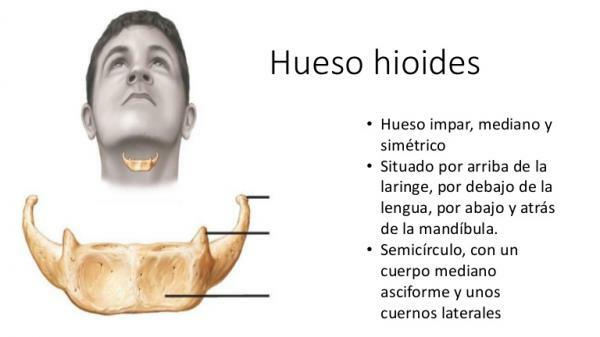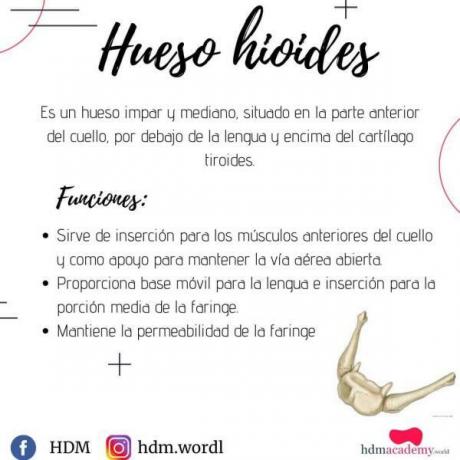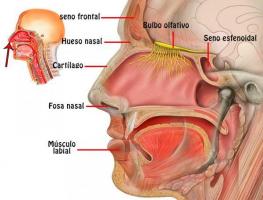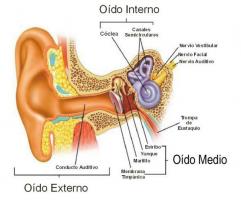HIOID bone: function and characteristics

The hyoid bone it's a little bone that we have in the throat. It is a bone with very special characteristics, for example: did you know that it is the only bone in our skeleton that is not directly connected to any other bone? It also performs different functions and all of them of vital importance. In this lesson from a TEACHER we will know what are the characteristics and functions of the hyoid bone.
The hyoid is part of the complex hio-glosso-pharyngeal, being a point of insertion of structures from the jaw, skull, tongue and pharynx. The hyoid which is located just by below the jaw, in front of the pharynx, suspended from the temporal bones of the skull by the style-hyoid ligaments. It's one of the Bones of the head and that has a very relevant importance in our skeletal system.
The hyoid bone is attached to 13 muscles that allow the bone to move up and down; contributing to the movement of the tongue, which is located above the bone, and the pharynx that is located below it; right at level of the third and fourth cervical vertebra.
In the hyoid bone a total of 13 muscles are inserted which are divided into two groups: the suprahyoid and infrahyoid muscles. Generally speaking, the suprahyoid muscle group (above the hyoid) advances and elevates the hyoid bone during swallowing (the action of swallowing food) and cause the jaw to drop when they contract, in combination with the isometric activity of the infrahyoid muscle group (which fix the position of the bone). In addition, the infrahyoid muscles cause the hyoid bone to descend during phonation.
On the other hand, the hyoid bone provides attachment to the fasciae (fibrous membrane that covers the surface of an organ) of the pharynx and the cervical vertebrae.

Image: Slideplayer
The hyoid bone It is a medium bone (located in the central axis of the body), odd (there is only one) symmetrical, U-shaped, and does not articulate directly to any other bone. Its name comes from the Greek word for horseshoe.
- It is a bone with a wider central part (Body), convex on its anterior-superior face and concave on its posterior-inferior face.
- Attached to each side of this central body are two long, thin, rod-shaped extensions called greater antlers.
- The greater antlers are attached to the central body by means of a small joint that receives the name of lesser antler. This articulation allows a slight movement of the greater antlers with respect to the central body.
As we have already briefly commented in the previous sections, the hyoid bone fulfills multiple functions related to breathing, swallowing, phonation and maintenance of head posture. In this section we will see in detail the different functions of the hyoid bone.
Chewing and swallowing
One function of the hyoid bone is to participate in the chewing process allowing the descent of the jaw thanks to the contraction of the suprahyoid muscles inserted in this bone. Simultaneously there is also the movement of the tongue that also participates in the chewing and swallowing process.
It also has a important role in swallowing, since, when the hyoid is raised and advanced, the volume of the oropharyngeal cavity (set of the cavity oral and pharynx) to allow the passage of the food bolus from the oral cavity to the upper tract of the apparatus digestive
On the other hand, the hyoid in combination with the muscles that are inserted into it, cause its elevation during swallowing, which allows the isolation of the oropharyngeal canal from the rhinopharyngeal by preventing food from regurgitating the food once it has been swallowed.
Pharyngeal airway maintenance
The hyoid bone is kept in a low position, the vasculae slightly backwards and the greater horns that widen the space that separates them, during aspiration (entry of air into the airways respiratory). On expiration (air exiting the airways), the hyoid ascends, vasculates slightly forward, and the ends of the greater horns approach each other.
Maintenance of postural balance of the head
The upright posture of the head it is possible thanks to the action of several muscles that establish a delicate balance. If this muscular work is not produced, the head would tilt forward, since its center of gravity is slightly advanced with respect to the axis of the spinal column.
The infrahyoid and suprahyoid muscles participate in the balance of muscle forces that allow maintaining the upright posture of the head, balancing the action of the cervical musculature that causes the head to tilt backwards; The phenomenon of straightening the head is the first step that the child takes, around 3 months of age, towards the acquisition of the bipedal posture and this is made possible by the development of the neck muscles, including the suprahyoid muscles and infrahyoids.
Protection of the larynx and pharynx
Protection of the larynx and pharynx is another function of the hyoid bone. Another function of the hyoid bone is the protection of the soft tissues of the larynx and pharynx.
Phonation
The hyoid bone contributes decisively to the emission of sounds by the phonation apparatus (phonoarticulation). During phonation, the hyoid descends, allowing the emission of sounds that allows the development of language in humans. The hyoid is the only bony element of the phonation apparatus, which is why it has become a key element in determining which was the language development in extinct human species.
The morphology of the hyoid bone is different in homo sapiens (modern humans) and in gorillas and chimpanzees. In the latter, the hyoid bone is not shaped like a horseshoe, but rather forms a box that houses the laryngeal sacs. In the oldest human fossils, the hyoid structure is similar to that of gorillas and chimpanzees, from which it is deduced that they did not have the ability to speak.
On the other hand, in the case of Neanderthals, the similarity of the hyoid bone with respect to homo sapiens, seems to indicate that this human species could have developed the capacity of the speaks.

Netter, Frank H. (2019). Atlas of Human Anatomy - 7th Edition Barcelona: Elsevier España, S.L.U.



